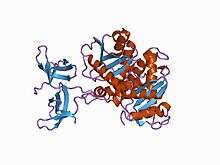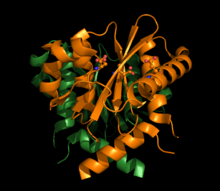Integrase
| Integrase Zinc binding domain | |||||||||
|---|---|---|---|---|---|---|---|---|---|
 solution structure of the n-terminal zn binding domain of hiv-1 integrase (e form), nmr, 38 structures | |||||||||
| Identifiers | |||||||||
| Symbol | Integrase_Zn | ||||||||
| Pfam | PF02022 | ||||||||
| InterPro | IPR003308 | ||||||||
| SCOP | 1wjb | ||||||||
| SUPERFAMILY | 1wjb | ||||||||
| |||||||||
| Integrase core domain | |||||||||
|---|---|---|---|---|---|---|---|---|---|
 crystal structure of rsv two-domain integrase | |||||||||
| Identifiers | |||||||||
| Symbol | rve | ||||||||
| Pfam | PF00665 | ||||||||
| Pfam clan | CL0219 | ||||||||
| InterPro | IPR001584 | ||||||||
| SCOP | 2itg | ||||||||
| SUPERFAMILY | 2itg | ||||||||
| |||||||||
| Integrase DNA binding domain | |||||||||
|---|---|---|---|---|---|---|---|---|---|
 crystal structure of rsv two-domain integrase | |||||||||
| Identifiers | |||||||||
| Symbol | IN_DBD_C | ||||||||
| Pfam | PF00552 | ||||||||
| InterPro | IPR001037 | ||||||||
| SCOP | 1ihw | ||||||||
| SUPERFAMILY | 1ihw | ||||||||
| |||||||||
Retroviral integrase (IN) is an enzyme produced by a retrovirus (such as HIV) that enables its genetic material to be integrated into the DNA of the infected cell. Retroviral INs are not to be confused with phage integrases, such as λ phage integrase (Int) (see site-specific recombination).
IN is a key component in the retroviral pre-integration complex (PIC). The complex of integrase bound to cognate viral DNA (vDNA) ends has been referred to as the intasome.[1]
Structure
All retroviral IN proteins contain three canonical domains, connected by flexible linkers:
- an N-terminal HH-CC zinc-binding domain (a three-helical bundle stabilised by coordination of a Zn(II) cation)
- a catalytic core domain (RNaseH fold)
- a C-terminal DNA-binding domain (SH3 fold)[2]
Crystal and NMR structures of the individual domains and 2-domain constructs of integrases from HIV-1, HIV-2, SIV, and Rous Sarcoma Virus (RSV) have been reported, with the first structures determined in 1994.
Biochemical data and structural data suggest that retroviral IN functions as a tetramer (dimer-of-dimers). All three domains are important for multimerisation and viral DNA binding. Early in 2010, scientists solved the crystal structure of IN from prototype foamy virus (PFV) assembled on viral DNA ends.[3]
In addition, several host cellular proteins have been shown to interact with IN to facilitate the integration process. Human chromatin-associated protein LEDGF, which tightly binds HIV IN and directs HIV PIC towards highly expressed genes for integration, is an example of such a host factor.
Function
Integration occurs following production of the double-stranded viral DNA by the viral RNA/DNA-dependent DNA polymerase reverse transcriptase.
The main function of IN is to insert the viral DNA into the host chromosomal DNA, a step that is essential for HIV replication. Integration is a point of no return for the cell, which becomes a permanent carrier of the viral genome (provirus). Integration is in part responsible for the persistence of retroviral infections. After integration, the viral gene expression and particle production may take place immediately or at some point in the future. The timing, it is presumed, depends on the activity of the chromosomal locus hosting the provirus.
Retroviral IN catalyzes two reactions:
- 3'-processing, in which two or three nucleotides are removed from one or both 3' ends of the viral DNA to expose the invariant CA dinucleotides at both 3'-ends of the viral DNA.
- the strand transfer reaction, in which the processed 3' ends of the viral DNA are covalently ligated to the host chromosomal DNA.
Both reactions are catalysed by the same active site and occur via transesterification, without a covalent protein-DNA intermediate, in contrast to reactions catalysed by Ser and Tyr recombinases (see site specific recombination).
HIV IN

HIV integrase is a 32 kDa protein produced from the C-terminal portion of the Pol gene product, and is an attractive target for new anti-HIV drugs.
In November 2005, data from a phase 2 study of an investigational HIV integrase inhibitor, MK-0518, demonstrated that the compound has potent antiviral activity.[4][5] On October 12, 2007, the Food and Drug Administration (U.S.) approved the integrase inhibitor Raltegravir (MK-0518, brand name Isentress).[6] The second integrase inhibitor, elvitegravir, was approved in the U.S. in August 2012.[7]
The crystal structure of human foamy virus integrase has been examined successfully.[8]
This protein may use the morpheein model of allosteric regulation.[9]
See also
References
- ↑ Masuda, Takao (2011-01-01). "Non-enzymatic functions of retroviral integrase: the next target for novel anti-HIV drug development". Virology. 2: 210. PMC 3192317
 . PMID 22016749. doi:10.3389/fmicb.2011.00210.
. PMID 22016749. doi:10.3389/fmicb.2011.00210. - ↑ Lodi PJ, Ernst JA, Kuszewski J, Hickman AB, Engelman A, Craigie R, Clore GM, Gronenborn AM (August 1995). "Solution structure of the DNA binding domain of HIV-1 integrase". Biochemistry. 34 (31): 9826–33. PMID 7632683. doi:10.1021/bi00031a002.
- ↑ "Scientists say crack HIV/AIDS puzzle for drugs". Reuters. January 31, 2010.
- ↑ Morales-Ramirez JO, Teppler H, Kovacs C, et al. Antiretroviral effect of MK-0518, a novel HIV-1 integrase inhibitor, in ART-naïve HIV-1 infected patients. Program and abstracts of the 10th European AIDS Conference; November 17–20, 2005; Dublin, Ireland. Abstract LBPS1/6. Online summary: http://clinicaloptions.com/HIV/Conference%20Coverage/Dublin%202005/Capsules/LBPS1-6.aspx
- ↑ Savarino A (December 2006). "A historical sketch of the discovery and development of HIV-1 integrase inhibitors". Expert Opin Investig Drugs. 15 (12): 1507–22. PMID 17107277. doi:10.1517/13543784.15.12.1507.
- ↑ "FDA approves drug that fights HIV in new way - CNN.com". CNN. October 12, 2007. Retrieved May 5, 2010.
- ↑ Sax PE, DeJesus E, Mills A, Zolopa A, Cohen C, Wohl D, Gallant JE, Liu HC, Zhong L, Yale K, White K, Kearney BP, Szwarcberg J, Quirk E, Cheng AK (June 2012). "Co-formulated elvitegravir, cobicistat, emtricitabine, and tenofovir versus co-formulated efavirenz, emtricitabine, and tenofovir for initial treatment of HIV-1 infection: a randomised, double-blind, phase 3 trial, analysis of results after 48 weeks". Lancet. 379 (9835): 2439–48. PMID 22748591. doi:10.1016/S0140-6736(12)60917-9.
- ↑ Hare S, Gupta SS, Valkov E, Engelman A, Cherepanov P (March 2010). "Retroviral intasome assembly and inhibition of DNA strand transfer". Nature. 464 (7286): 232–6. PMC 2837123
 . PMID 20118915. doi:10.1038/nature08784.
. PMID 20118915. doi:10.1038/nature08784. - ↑ Selwood T, Jaffe EK (March 2012). "Dynamic dissociating homo-oligomers and the control of protein function". Arch. Biochem. Biophys. 519 (2): 131–43. PMC 3298769
 . PMID 22182754. doi:10.1016/j.abb.2011.11.020.
. PMID 22182754. doi:10.1016/j.abb.2011.11.020.
External links
- Integrases at the US National Library of Medicine Medical Subject Headings (MeSH)